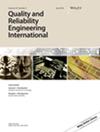Reliability evaluation for Weibull distribution with heavily Type II censored data
IF 2.8
3区 工程技术
Q3 ENGINEERING, INDUSTRIAL
引用次数: 0
Abstract
The lifetime data collected from the field are usually heavily censored, in which case, getting an accurate reliability evaluation based on heavily censored data is challenging. For heavily Type‐II censored data, the parameters estimation bias of traditional methods (i.e., maximum likelihood estimation (MLE) and least squares estimation (LSE)) are still large, and Bayesian methods are hard to specify the priors in practice. Therefore, considering the existing range of shape parameter for Weibull distribution, this study proposes two novel parameter estimation methods, the three‐step MLE method and the hybrid estimation method. For the three‐step MLE method, the initial estimates of shape and scale parameters are first respectively derived using MLE, then are updated by the single parameter MLE method with the range constraint of shape parameter. For the hybrid estimation method, the shape parameter is estimated by the LSE method with the existing range constraint of shape parameter, then the scale parameter estimate can be obtained by MLE. On this basis, two numerical examples are performed to demonstrate the consistency and effectiveness of the proposed methods. Finally, a case study on turbine engines is given to verify the effectiveness and applicability of the proposed methods.带有严重 II 型删减数据的 Weibull 分布的可靠性评估
从现场收集到的寿命数据通常会严重删减,在这种情况下,根据严重删减的数据进行准确的可靠性评估具有挑战性。对于重Ⅱ类剔除数据,传统方法(即最大似然估计(MLE)和最小二乘估计(LSE))的参数估计偏差仍然很大,而贝叶斯方法在实践中很难指定先验值。因此,考虑到 Weibull 分布形状参数的现有范围,本研究提出了两种新的参数估计方法,即三步 MLE 法和混合估计法。在三步 MLE 法中,首先使用 MLE 分别得到形状参数和尺度参数的初始估计值,然后使用单参数 MLE 法更新形状参数的范围约束。对于混合估算方法,形状参数是通过 LSE 方法在现有形状参数范围约束下进行估算的,然后再通过 MLE 获得尺度参数估算值。在此基础上,通过两个数值实例证明了所提方法的一致性和有效性。最后,通过对涡轮发动机的案例研究,验证了所提方法的有效性和适用性。
本文章由计算机程序翻译,如有差异,请以英文原文为准。
求助全文
约1分钟内获得全文
求助全文
来源期刊
CiteScore
4.90
自引率
21.70%
发文量
181
审稿时长
6 months
期刊介绍:
Quality and Reliability Engineering International is a journal devoted to practical engineering aspects of quality and reliability. A refereed technical journal published eight times per year, it covers the development and practical application of existing theoretical methods, research and industrial practices. Articles in the journal will be concerned with case studies, tutorial-type reviews and also with applications of new or well-known theory to the solution of actual quality and reliability problems in engineering.
Papers describing the use of mathematical and statistical tools to solve real life industrial problems are encouraged, provided that the emphasis is placed on practical applications and demonstrated case studies.
The scope of the journal is intended to include components, physics of failure, equipment and systems from the fields of electronic, electrical, mechanical and systems engineering. The areas of communications, aerospace, automotive, railways, shipboard equipment, control engineering and consumer products are all covered by the journal.
Quality and reliability of hardware as well as software are covered. Papers on software engineering and its impact on product quality and reliability are encouraged. The journal will also cover the management of quality and reliability in the engineering industry.
Special issues on a variety of key topics are published every year and contribute to the enhancement of Quality and Reliability Engineering International as a major reference in its field.

 求助内容:
求助内容: 应助结果提醒方式:
应助结果提醒方式:


